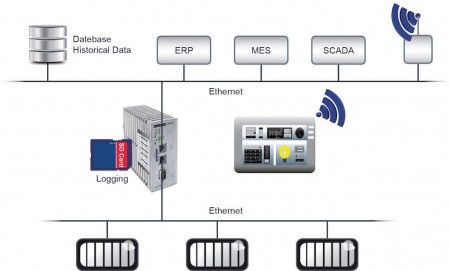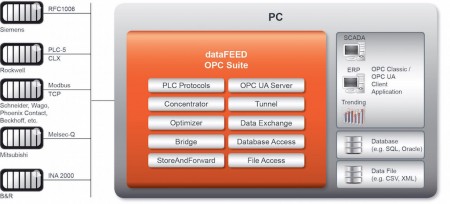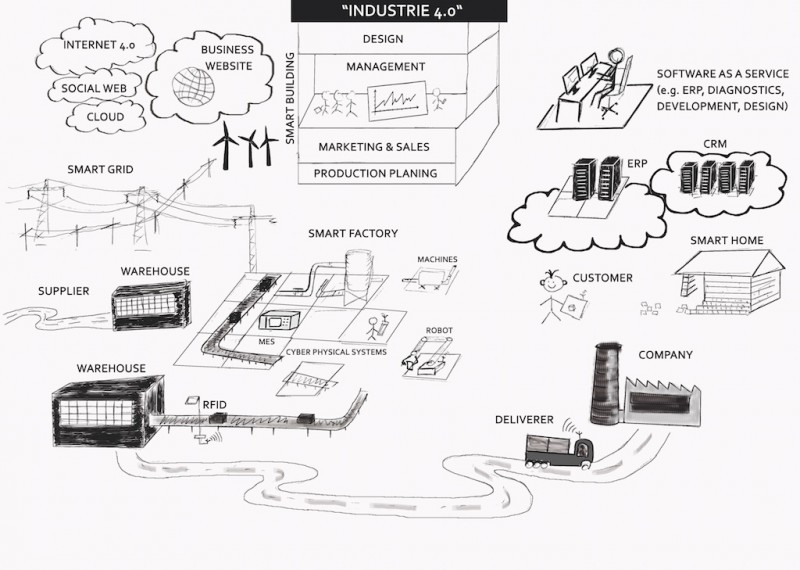Easy linking of production world and IT world through OPC UA
Since the release of the first version of the standard about 20 years ago, OPC technology has become established in the industry as the de‑facto standard for vendor-independent data exchange. A major reason for its success is that it eliminates the need to spend a lot of time and work developing proprietary communication interfaces. The OPC Classic standard is based on Microsoft’s COM/DCOM model and the Windows platform. However, recent developments in the automation world – and in industrial data processing in general – are exceedingly difficult to map onto the OPC Classic standard. To solve this issue, the OPC Foundation has further developed the standard into the OPC Unified Architecture (UA) which provides solutions to the identified drawbacks of OPC Classic while meeting the requirements for use in a modern device architecture.
New possibilities with OPC UA
OPC UA extends OPC Classic by adding important capabilities, such as platform independence, scalability and high availability. Some of its key features are that OPC UA is service-based and enables the central transfer of data over the Internet. This is accomplished through a unified information model that includes program calls and supports complex data structures, as required e.g. for the execution of multi-level tasks such as batch processing. The newly defined communication protocol is based on TCP. Only the Ethernet port 4840 needs to be enabled. In this way OPC UA allows data exchange between computers – also across firewall boundaries – and can be used with non-Windows computers. Designed to ensure reliable communications, the OPC UA standard offers the possibility to monitor the connections in order to buffer the data if a connection breaks, and forward it as soon as the connection is re-established. In addition, the optional implementation of full or partial redundancy improves data security. The OPC UA standard defines a comprehensive security concept, which is based on proven Internet security mechanisms. It supports user authentication by user name and password or, alternatively, the authentication of the application by digital certificates. 128-bit or 256-bit encryption can be optionally used for data exchange.
On the way to the Internet of Things
By providing all these additional capabilities, OPC UA paves the way for the implementation of new concepts with increased vertical and horizontal data integration, and opens the door to industries requiring seamless data logging. Supporting use in both PCs and embedded systems, OPC UA technology allows the implementation of solutions that move intelligence from the supervisory control systems to the local components. This makes it possible to remotely use and process the available data and information, creating new value chains and business models. As a result OPC UA is becoming established as the ideal foundation for turning the vision of an “Internet of Things” for factory environments into reality. The aim is to globally network all machines, warehouse systems and operating resources and make them available to production with decentralized intelligence, which locally and autonomously optimizes the manufacture, provides the products with a unique ID and determines the state and location of each product at any time. This vision is also pursued in the strategic initiative “Industrie 4.0” launched by the German government.
OPC UA products in real-world applications
 A look at the OPC UA products available in the market shows that this technology offers the basis for data exchange in a comprehensive Internet-of-Things implementation. For example, the echocollect e (OPC) product from Softing Industrial Automation links the control world with the IT world, giving access to process, manufacturing and quality data in more than 50 different controller types. For connection to higher-level systems, an embedded OPC UA Server integrated into the hardware provides read, write and cyclic access to all the data in the controllers.
A look at the OPC UA products available in the market shows that this technology offers the basis for data exchange in a comprehensive Internet-of-Things implementation. For example, the echocollect e (OPC) product from Softing Industrial Automation links the control world with the IT world, giving access to process, manufacturing and quality data in more than 50 different controller types. For connection to higher-level systems, an embedded OPC UA Server integrated into the hardware provides read, write and cyclic access to all the data in the controllers.
echocollect e (OPC) is designed for easy configuration of the control data. For leading controller systems it includes simple-to-use functionality for importing (from Siemens S7 projects) and online browsing (in Rockwell ControlLogix controllers). The user interface is preset with field-proven default settings. Integrating the controllers requires no adjustments to the control program and thus supports quick and easy commissioning. Changes to the configuration can be made without restarting the installation.
Ideal connecting link
Thanks to the embedded OPC UA Server, echocollect e (OPC) has the advantage that legacy installations and machines with controllers that do not support OPC UA Servers can be integrated into management systems that have an OPC UA Client. This allows the implementation of heterogeneous architectures and solutions without Windows PCs. Once configured, echocollect e (OPC) will work for years – untouched, without updates, and with zero maintenance costs.
The benefits of echocollect e (OPC) are apparent, for example, when used for implementing product control in a network of plants around the world, as in the example of an automotive supplier. This global presence makes it necessary to network the systems used worldwide in order to fully synchronize the machines and equipment with the resource planning and manufacturing control systems. A key requirement to achieve this is the seamless vertical exchange of data between the control, management and data integration levels in order to forward and concentrate the production data and transfer recipes to the controllers. Deciding factors in choosing echocollect e (OPC) in this application example were the easy integration of all the control platforms used, its support of a standardized interface for the integration of higher-level management systems, and its quick and easy configuration and commissioning.
Ready-to-use all-in-one solution
 Another Softing product supporting the OPC UA standard is the dataFEED OPC Suite. This pure all-in-one software solution for use on PC platforms combines all the components for data exchange via OPC in one product. It not only provides access to controllers from leading manufacturers, such as Siemens, Rockwell, Mitsubishi and B&R, but also includes functionalities for tunnel implementation to avoid DCOM problems and for improving the communication between the controllers, OPC Servers and OPC Clients, regardless of whether they use OPC Classic or OPC UA.
Another Softing product supporting the OPC UA standard is the dataFEED OPC Suite. This pure all-in-one software solution for use on PC platforms combines all the components for data exchange via OPC in one product. It not only provides access to controllers from leading manufacturers, such as Siemens, Rockwell, Mitsubishi and B&R, but also includes functionalities for tunnel implementation to avoid DCOM problems and for improving the communication between the controllers, OPC Servers and OPC Clients, regardless of whether they use OPC Classic or OPC UA.
Thanks to the integrated dataFEED OPC Server, any OPC Client application has read and write access to all input and output data, data blocks, markers, timers and counters in the controllers without requiring changes to the control program. The incorporated OPC UA Server even offers the possibility to integrate non-OPC UA enabled components, such as Siemens S5 controllers, into OPC UA Client applications. It thus allows continued use of legacy components and saves costs. The dataFEED OPC Suite functionality is complemented by functionality for the storage of process data and local data in SQL databases and text files. This makes it possible, for example, to provide required proof (e.g. of material consumption) or perform analyses assessing the potential for process optimization.
The future belongs to OPC UA
Based on OPC’s market penetration over the years and the proven success of deployed solutions, OPC UA technology has quickly become established as an open standard that ensures independence of proprietary solutions while guaranteeing future-proof interoperability. Another reason for the rapidly growing acceptance is that OPC UA can be used without requiring changes to existing systems, as this technology can also be used together with OPC Classic applications. The best fitting solution can thus be chosen based on the individual requirements, e.g. whether it is better to use a hardware product or a pure software solution.
